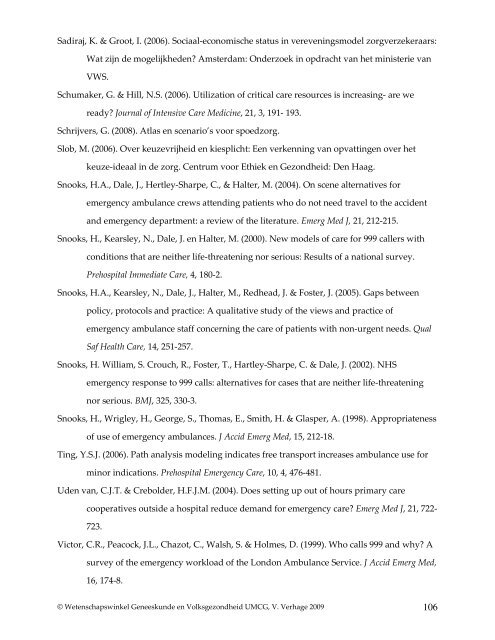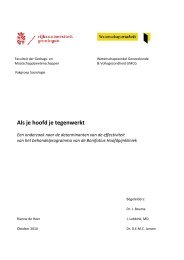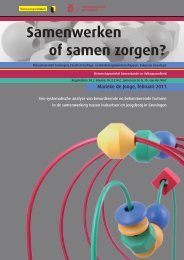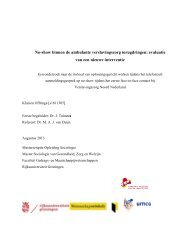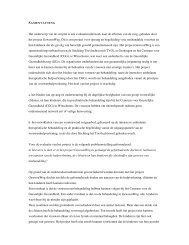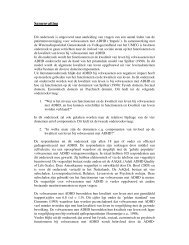Umcg - Wetenschapswinkel Geneeskunde en Volksgezondheid
Umcg - Wetenschapswinkel Geneeskunde en Volksgezondheid
Umcg - Wetenschapswinkel Geneeskunde en Volksgezondheid
You also want an ePaper? Increase the reach of your titles
YUMPU automatically turns print PDFs into web optimized ePapers that Google loves.
Sadiraj, K. & Groot, I. (2006). Sociaal-economische status in verev<strong>en</strong>ingsmodel zorgverzekeraars:<br />
Wat zijn de mogelijkhed<strong>en</strong>? Amsterdam: Onderzoek in opdracht van het ministerie van<br />
VWS.<br />
Schumaker, G. & Hill, N.S. (2006). Utilization of critical care resources is increasing- are we<br />
ready? Journal of Int<strong>en</strong>sive Care Medicine, 21, 3, 191- 193.<br />
Schrijvers, G. (2008). Atlas <strong>en</strong> sc<strong>en</strong>ario’s voor spoedzorg.<br />
Slob, M. (2006). Over keuzevrijheid <strong>en</strong> kiesplicht: E<strong>en</strong> verk<strong>en</strong>ning van opvatting<strong>en</strong> over het<br />
keuze-ideaal in de zorg. C<strong>en</strong>trum voor Ethiek <strong>en</strong> Gezondheid: D<strong>en</strong> Haag.<br />
Snooks, H.A., Dale, J., Hertley-Sharpe, C., & Halter, M. (2004). On sc<strong>en</strong>e alternatives for<br />
emerg<strong>en</strong>cy ambulance crews att<strong>en</strong>ding pati<strong>en</strong>ts who do not need travel to the accid<strong>en</strong>t<br />
and emerg<strong>en</strong>cy departm<strong>en</strong>t: a review of the literature. Emerg Med J, 21, 212-215.<br />
Snooks, H., Kearsley, N., Dale, J. <strong>en</strong> Halter, M. (2000). New models of care for 999 callers with<br />
conditions that are neither life-threat<strong>en</strong>ing nor serious: Results of a national survey.<br />
Prehospital Immediate Care, 4, 180-2.<br />
Snooks, H.A., Kearsley, N., Dale, J., Halter, M., Redhead, J. & Foster, J. (2005). Gaps betwe<strong>en</strong><br />
policy, protocols and practice: A qualitative study of the views and practice of<br />
emerg<strong>en</strong>cy ambulance staff concerning the care of pati<strong>en</strong>ts with non-urg<strong>en</strong>t needs. Qual<br />
Saf Health Care, 14, 251-257.<br />
Snooks, H. William, S. Crouch, R., Foster, T., Hartley-Sharpe, C. & Dale, J. (2002). NHS<br />
emerg<strong>en</strong>cy response to 999 calls: alternatives for cases that are neither life-threat<strong>en</strong>ing<br />
nor serious. BMJ, 325, 330-3.<br />
Snooks, H., Wrigley, H., George, S., Thomas, E., Smith, H. & Glasper, A. (1998). Appropriat<strong>en</strong>ess<br />
of use of emerg<strong>en</strong>cy ambulances. J Accid Emerg Med, 15, 212-18.<br />
Ting, Y.S.J. (2006). Path analysis modeling indicates free transport increases ambulance use for<br />
minor indications. Prehospital Emerg<strong>en</strong>cy Care, 10, 4, 476-481.<br />
Ud<strong>en</strong> van, C.J.T. & Crebolder, H.F.J.M. (2004). Does setting up out of hours primary care<br />
cooperatives outside a hospital reduce demand for emerg<strong>en</strong>cy care? Emerg Med J, 21, 722-<br />
723.<br />
Victor, C.R., Peacock, J.L., Chazot, C., Walsh, S. & Holmes, D. (1999). Who calls 999 and why? A<br />
survey of the emerg<strong>en</strong>cy workload of the London Ambulance Service. J Accid Emerg Med,<br />
16, 174-8.<br />
© <strong>Wet<strong>en</strong>schapswinkel</strong> <strong>G<strong>en</strong>eeskunde</strong> <strong>en</strong> <strong>Volksgezondheid</strong> UMCG, V. Verhage 2009 106


